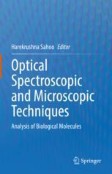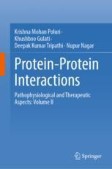Search
Search Results
-
A multilayer dynamic perturbation analysis method for predicting ligand–protein interactions
BackgroundLigand–protein interactions play a key role in defining protein function, and detecting natural ligands for a given protein is thus a very...

-
Protein-Ligand Interactions Methods and Applications
This third edition provides new and updated chapters detailing a complete introduction to common and emerging procedures for characterizing the...

-
Steady-State Fluorescence Spectroscopy as a Tool to Monitor Protein/Ligand Interactions
Fluorescence spectroscopy is an ideal and powerful methodology for the potent and reliable study of protein–ligand interactions. Enhanced...
-
Molecular Dynamics Simulation to Study Protein Conformation and Ligand Interaction
The field of molecular dynamics (MD) simulations has become indispensable today to studying the conformational flexibility and dynamics of proteins...
-
Differences in ligand-induced protein dynamics extracted from an unsupervised deep learning approach correlate with protein–ligand binding affinities
Prediction of protein–ligand binding affinity is a major goal in drug discovery. Generally, free energy gap is calculated between two states (e.g.,...

-
Protein-Protein Interactions Pathophysiological and Therapeutic Aspects: Volume II
The second volume of the book-Protein-Protein Interactions (PPIs) provides an overview of various protein-protein interactions (PPIs) that are...

-
CurvAGN: Curvature-based Adaptive Graph Neural Networks for Predicting Protein-Ligand Binding Affinity
Accurately predicting the binding affinity between proteins and ligands is crucial for drug discovery. Recent advances in graph neural networks...

-
End-to-end protein–ligand complex structure generation with diffusion-based generative models
BackgroundThree-dimensional structures of protein–ligand complexes provide valuable insights into their interactions and are crucial for molecular...

-
Outliers in SAR and QSAR: 4. effects of allosteric protein–ligand interactions on the classical quantitative structure–activity relationships
Effects of allosteric interactions on the classical structure–activity relationship (SAR) and quantitative SAR (QSAR) have been investigated....

-
Binding affinity prediction for protein–ligand complex using deep attention mechanism based on intermolecular interactions
BackgroundAccurate prediction of protein–ligand binding affinity is important for lowering the overall cost of drug discovery in structure-based drug...

-
Rational Design of Drugs Targeting G-Protein-Coupled Receptors: Ligand Search and Screening
AbstractG protein-coupled receptors (GPCRs) are transmembrane proteins that participate in many physiological processes and represent major...

-

-
Protein-Ligand Binding with Applications in Molecular Docking
Protein-ligand binding underlies several biological processes, such as cellular signal cascades, viral mechanisms of immune evasion, and protein...
-
Prediction of protein–ligand binding affinity from sequencing data with interpretable machine learning
Protein–ligand interactions are increasingly profiled at high throughput using affinity selection and massively parallel sequencing. However, these...

-
Structural basis for the ligand promiscuity of the neofunctionalized, carotenoid-binding fasciclin domain protein AstaP
Fasciclins (FAS1) are ancient adhesion protein domains with no common small ligand binding reported. A unique microalgal FAS1-containing astaxanthin...

-
Electronic and ring size effects of N-heterocyclic carbenes on the kinetics of ligand substitution reactions and DNA/protein interactions of their palladium(II) complexes
The synthesis, substitution kinetics and DNA/BSA interactions of four cationic Pd(II) complexes [Pd( 1 )Cl]BF 4 ( Pd1 ), [Pd( 2 )Cl]BF 4 ( Pd2 ), [Pd( 3 )Cl]BF 4 (

-
Systematic assessment of chemokine ligand bias at the human chemokine receptor CXCR2 indicates G protein bias over β-arrestin recruitment and receptor internalization
BackgroundThe human CXC chemokine receptor 2 (CXCR2) is a G protein-coupled receptor (GPCR) interacting with multiple chemokines ( i.e. , CXC...

-
A reinforcement learning approach for protein–ligand binding pose prediction
Protein ligand docking is an indispensable tool for computational prediction of protein functions and screening drug candidates. Despite significant...

-
Elucidating Protein-Ligand Interactions Using High Throughput Biophysical Techniques
Proteins are large, complex molecules that functionally regulates almost all cellular and biochemical processes. As proteins are important component...
-
Isothermal Titration Calorimetry to Study Plant Peptide Ligand-Receptor Interactions
The field of plant receptor biology has rapidly expanded in the past three decades. However, the demonstration of direct interaction between...
